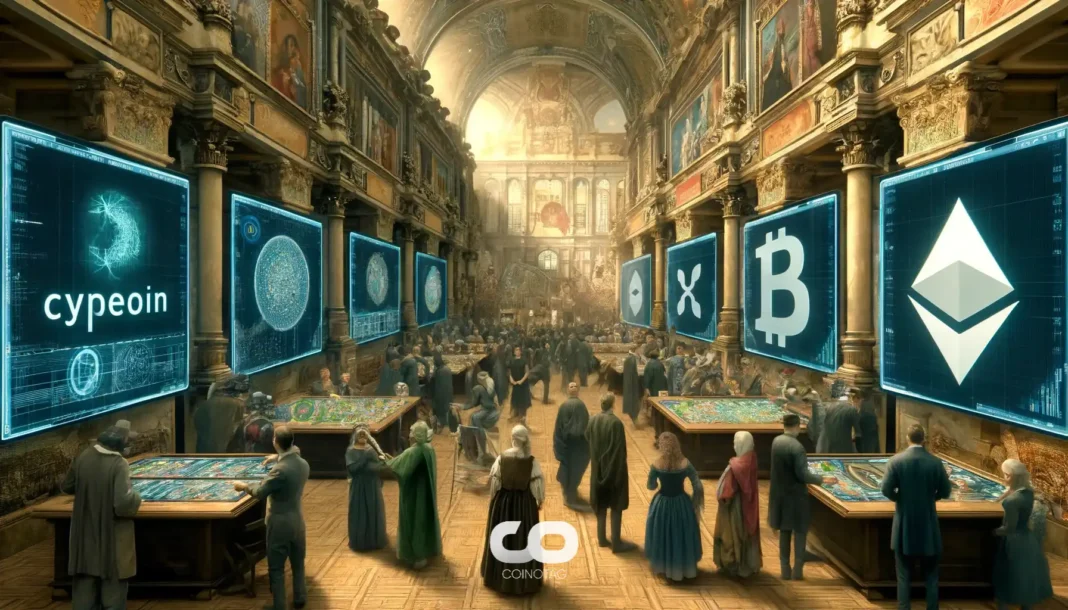| COINOTAG recommends • Exchange signup |
| 💹 Trade with pro tools |
| Fast execution, robust charts, clean risk controls. |
| 👉 Open account → |
| COINOTAG recommends • Exchange signup |
| 🚀 Smooth orders, clear control |
| Advanced order types and market depth in one view. |
| 👉 Create account → |
| COINOTAG recommends • Exchange signup |
| 📈 Clarity in volatile markets |
| Plan entries & exits, manage positions with discipline. |
| 👉 Sign up → |
| COINOTAG recommends • Exchange signup |
| ⚡ Speed, depth, reliability |
| Execute confidently when timing matters. |
| 👉 Open account → |
| COINOTAG recommends • Exchange signup |
| 🧭 A focused workflow for traders |
| Alerts, watchlists, and a repeatable process. |
| 👉 Get started → |
| COINOTAG recommends • Exchange signup |
| ✅ Data‑driven decisions |
| Focus on process—not noise. |
| 👉 Sign up → |
-
Core DAO and Element Wallet are pioneering efforts to boost Bitcoin’s functionality, opening doors to innovative decentralized finance (DeFi) applications.
-
The collaboration between these two platforms not only enhances DeFi access for Bitcoin users but also places a premium on individual privacy and security.
-
“Our goal is to ensure that Bitcoin users can engage fully with DeFi without compromising their privacy,” noted Bruna Brambatti from Element Wallet.
Core DAO and Element Wallet unite to enhance Bitcoin’s utility and ensure user privacy, paving the way for innovative DeFi participation.
Expanding Bitcoin Use Cases
As part of its roadmap for 2025, the CORE team is committed to diversifying Bitcoin’s utility for holders who seek to actively utilize their BTC rather than simply store it. This is achieved through streamlined access to decentralized finance.
“A lot of people have been holding Bitcoin over the years and are totally happy with that. I get it, myself included, but there are also a lot of people who want to actually do something with their BTC and not just hold it. They want to actually put it to work, bring it into DeFi, take out a loan on it, or lend it out and earn some yield. Core basically allows for whatever you want to do with your Bitcoin,” explained Dylan Dennis, Contributor at Core DAO.
Core is unique in its approach, as it functions as a layer-1 blockchain that integrates seamlessly with Bitcoin while offering Ethereum Virtual Machine (EVM) compatibility. Since its launch in January 2023, the project has already garnered a market capitalization exceeding $497 million.
| COINOTAG recommends • Professional traders group |
| 💎 Join a professional trading community |
| Work with senior traders, research‑backed setups, and risk‑first frameworks. |
| 👉 Join the group → |
| COINOTAG recommends • Professional traders group |
| 📊 Transparent performance, real process |
| Spot strategies with documented months of triple‑digit runs during strong trends; futures plans use defined R:R and sizing. |
| 👉 Get access → |
| COINOTAG recommends • Professional traders group |
| 🧭 Research → Plan → Execute |
| Daily levels, watchlists, and post‑trade reviews to build consistency. |
| 👉 Join now → |
| COINOTAG recommends • Professional traders group |
| 🛡️ Risk comes first |
| Sizing methods, invalidation rules, and R‑multiples baked into every plan. |
| 👉 Start today → |
| COINOTAG recommends • Professional traders group |
| 🧠 Learn the “why” behind each trade |
| Live breakdowns, playbooks, and framework‑first education. |
| 👉 Join the group → |
| COINOTAG recommends • Professional traders group |
| 🚀 Insider • APEX • INNER CIRCLE |
| Choose the depth you need—tools, coaching, and member rooms. |
| 👉 Explore tiers → |

The Core DAO supports and develops the Core blockchain with a focus on community-driven collaboration, security, and scalability. Their initiative, termed BTCfi, aims to create decentralized financial services built on a Bitcoin-based blockchain. This initiative seeks to marry Bitcoin’s robust security with the innovative financial solutions found in DeFi.
| COINOTAG recommends • Exchange signup |
| 📈 Clear interface, precise orders |
| Sharp entries & exits with actionable alerts. |
| 👉 Create free account → |
| COINOTAG recommends • Exchange signup |
| 🧠 Smarter tools. Better decisions. |
| Depth analytics and risk features in one view. |
| 👉 Sign up → |
| COINOTAG recommends • Exchange signup |
| 🎯 Take control of entries & exits |
| Set alerts, define stops, execute consistently. |
| 👉 Open account → |
| COINOTAG recommends • Exchange signup |
| 🛠️ From idea to execution |
| Turn setups into plans with practical order types. |
| 👉 Join now → |
| COINOTAG recommends • Exchange signup |
| 📋 Trade your plan |
| Watchlists and routing that support focus. |
| 👉 Get started → |
| COINOTAG recommends • Exchange signup |
| 📊 Precision without the noise |
| Data‑first workflows for active traders. |
| 👉 Sign up → |
This collaboration not only enhances Bitcoin’s overall value by broadening its transactional capabilities but also offers new opportunities for users to engage with decentralized applications.
Moreover, Core’s EVM compatibility permits developers to utilize established Ethereum tools to create interoperable decentralized applications (dApps), catering to a wide array of user needs, from basic BTC staking to complex DeFi integrations.
| COINOTAG recommends • Traders club |
| ⚡ Futures with discipline |
| Defined R:R, pre‑set invalidation, execution checklists. |
| 👉 Join the club → |
| COINOTAG recommends • Traders club |
| 🎯 Spot strategies that compound |
| Momentum & accumulation frameworks managed with clear risk. |
| 👉 Get access → |
| COINOTAG recommends • Traders club |
| 🏛️ APEX tier for serious traders |
| Deep dives, analyst Q&A, and accountability sprints. |
| 👉 Explore APEX → |
| COINOTAG recommends • Traders club |
| 📈 Real‑time market structure |
| Key levels, liquidity zones, and actionable context. |
| 👉 Join now → |
| COINOTAG recommends • Traders club |
| 🔔 Smart alerts, not noise |
| Context‑rich notifications tied to plans and risk—never hype. |
| 👉 Get access → |
| COINOTAG recommends • Traders club |
| 🤝 Peer review & coaching |
| Hands‑on feedback that sharpens execution and risk control. |
| 👉 Join the club → |
“Basically, Core was created by Bitcoiners. The whole point of Core is to scale Bitcoin and unlock new use cases for every kind of Bitcoiner, whether you’re someone who wants to take no new risk, and just keep your BTC in your wallet. Then on the other side, there’s this whole Bitcoin DeFi ecosystem, with 100+ Dapps, all BTC-based. Whatever you want to do with your BTC you could do it with Core,” Dennis said.
The Satoshi Plus Consensus for Ensured Decentralization
In alignment with Bitcoin’s foundational values of decentralization and security, Core utilizes a method known as the Satoshi Plus Consensus. This approach integrates contributions from Bitcoin miners, CORE stakers, and Bitcoin stakers, creating a robust security framework.
With this model, Bitcoin miners can enhance the broader network’s security without having to sacrifice their existing Proof-of-Work (PoW) contributions by delegating their validation responsibilities to Core validators.
This innovative approach also leverages a delegated Proof-of-Stake (dPoS) mechanism, allowing CORE token holders to bolster network security by delegating their tokens. Moreover, it incorporates non-custodial Bitcoin staking, providing users with an additional layer of operational security.
| COINOTAG recommends • Exchange signup |
| 📈 Clear control for futures |
| Sizing, stops, and scenario planning tools. |
| 👉 Open futures account → |
| COINOTAG recommends • Exchange signup |
| 🧩 Structure your futures trades |
| Define entries & exits with advanced orders. |
| 👉 Sign up → |
| COINOTAG recommends • Exchange signup |
| 🛡️ Control volatility |
| Automate alerts and manage positions with discipline. |
| 👉 Get started → |
| COINOTAG recommends • Exchange signup |
| ⚙️ Execution you can rely on |
| Fast routing and meaningful depth insights. |
| 👉 Create account → |
| COINOTAG recommends • Exchange signup |
| 📒 Plan. Execute. Review. |
| Frameworks for consistent decision‑making. |
| 👉 Join now → |
| COINOTAG recommends • Exchange signup |
| 🧩 Choose clarity over complexity |
| Actionable, pro‑grade tools—no fluff. |
| 👉 Open account → |
“With the non-custodial staking, you can stake Bitcoin in your own wallet by putting a time lock on it. It’s called a time lock contract and it’s a Bitcoin native feature. You lock it in that transaction, you include the validator you want to delegate to, and for helping to decentralize and secure the core network, you get paid out in Core tokens for doing so without any new trust assumptions,” Dennis explained.
While Core serves Bitcoin holders, Element Wallet focuses on protecting user privacy and the secure management of digital assets.
| COINOTAG recommends • Members‑only research |
| 📌 Curated setups, clearly explained |
| Entry, invalidation, targets, and R:R defined before execution. |
| 👉 Get access → |
| COINOTAG recommends • Members‑only research |
| 🧠 Data‑led decision making |
| Technical + flow + context synthesized into actionable plans. |
| 👉 Join now → |
| COINOTAG recommends • Members‑only research |
| 🧱 Consistency over hype |
| Repeatable rules, realistic expectations, and a calmer mindset. |
| 👉 Get access → |
| COINOTAG recommends • Members‑only research |
| 🕒 Patience is an edge |
| Wait for confirmation and manage risk with checklists. |
| 👉 Join now → |
| COINOTAG recommends • Members‑only research |
| 💼 Professional mentorship |
| Guidance from seasoned traders and structured feedback loops. |
| 👉 Get access → |
| COINOTAG recommends • Members‑only research |
| 🧮 Track • Review • Improve |
| Documented PnL tracking and post‑mortems to accelerate learning. |
| 👉 Join now → |
Addressing User Privacy and Asset Security
While the transparency of the Core blockchain enhances security, it can create concerns regarding user privacy. Bruna Brambatti, Marketing Manager at Element Wallet, emphasizes the importance of user privacy within the crypto space.
“You’re going to see a lot of people that have random handles. They’re not using their profile picture. They are using an NFT. People like to be private and want to keep their money private. Even though we have this open space with the blockchain, we’re never going to know who the owner of that money in that wallet is,” she explained.
| COINOTAG recommends • Exchange signup |
| 🎯 Focus on process over noise |
| Plan trades, size positions, execute consistently. |
| 👉 Sign up → |
| COINOTAG recommends • Exchange signup |
| 🛠️ Simplify execution |
| Keep decisions clear with practical controls. |
| 👉 Get started → |
| COINOTAG recommends • Exchange signup |
| 📊 Make data your edge |
| Use depth and alerts to avoid guesswork. |
| 👉 Open account → |
| COINOTAG recommends • Exchange signup |
| 🧭 Be prepared, not reactive |
| Turn setups into rules before you trade. |
| 👉 Create account → |
| COINOTAG recommends • Exchange signup |
| ✍️ Plan first, then act |
| Entries, exits, and reviews that fit your routine. |
| 👉 Join now → |
| COINOTAG recommends • Exchange signup |
| 🧩 Consistency beats intensity |
| Small, repeatable steps win the long run. |
| 👉 Sign up → |
The Element Wallet is designed for multi-chain crypto asset management, enhancing user access to DeFi while initially focusing on the Core ecosystem. To protect user identity and financial data, the wallet incorporates end-to-end encrypted messaging, ensuring that only the intended recipient can view the content.
Additionally, Element Wallet facilitates peer-to-peer (P2P) payment transfers directly within its messaging system, adding a layer of security and user-friendly functionality.
| COINOTAG recommends • Premium trading community |
| 🏛️ WAGMI CAPITAL — Premium Trading Community |
| Strategic insights, exclusive opportunities, professional support. |
| 👉 Join WAGMI CAPITAL → |
| COINOTAG recommends • Premium trading community |
| 💬 Inner Circle access |
| See members share real‑time PnL and execution notes in chat. |
| 👉 Apply for Inner Circle → |
| COINOTAG recommends • Premium trading community |
| 🧩 Turn theses into trades |
| Reusable templates for entries, risk, and review—end to end. |
| 👉 Join the club → |
| COINOTAG recommends • Premium trading community |
| 💡 Long‑term mindset |
| Patience and discipline over noise; a process that compounds. |
| 👉 Get started → |
| COINOTAG recommends • Premium trading community |
| 📚 Education + execution |
| Courses, playbooks, and live market walkthroughs—learn by doing. |
| 👉 Get access → |
| COINOTAG recommends • Premium trading community |
| 🔒 Members‑only research drops |
| Curated analyses and private briefings—quality over quantity. |
| 👉 Join WAGMI CAPITAL → |
“We never, ever have access to anyone’s funds or their seed phrases. We do believe that the owners should have power over their assets and trust that they are theirs,” Brambatti added.
Breaking Down Web3 Complexities
The partnership between Core and Element centers on the community, with both organizations prioritizing user engagement and simplifying the onboarding process. Sean Schireson, Head of Product at Element Wallet, noted the essential role user experience plays in promoting broader adoption.
| COINOTAG recommends • Exchange signup |
| 🧱 Execute with discipline |
| Watchlists, alerts, and flexible order control. |
| 👉 Sign up → |
| COINOTAG recommends • Exchange signup |
| 🧩 Keep your strategy simple |
| Clear rules and repeatable steps. |
| 👉 Open account → |
| COINOTAG recommends • Exchange signup |
| 🧠 Stay objective |
| Let data—not emotion—drive actions. |
| 👉 Get started → |
| COINOTAG recommends • Exchange signup |
| ⏱️ Trade when it makes sense |
| Your plan sets the timing—not the feed. |
| 👉 Join now → |
| COINOTAG recommends • Exchange signup |
| 🌿 A calm plan for busy markets |
| Set size and stops first, then execute. |
| 👉 Create account → |
| COINOTAG recommends • Exchange signup |
| 🧱 Your framework. Your rules. |
| Design entries/exits that fit your routine. |
| 👉 Sign up → |
“We’re really focused on simplifying the kinds of Web3 complexities that are often found in the space today. As we work closely with the Core DAO and the core team, we find more opportunities to really make UX be at the forefront,” he explained.
The Element Wallet enhances user experience across the Core chain and enables users to perform various transactions within a single application, unifying functionalities for ease of use.
The Core team has introduced Sparks, a dynamic rewards system that incentivizes community involvement and delineates user contributions to the Core ecosystem. Active participants earn Sparks based on their engagement levels.
“What we want to do is make that entry point feel like a consumer app that you’ve used and loved before. And that’s really our gold element. We’re not trying to reinvent the wheel, but we’re definitely trying to put a new spin on an otherwise kind of saturated UX market,” Schireson concluded.
This focus on improving user experience and fostering community engagement aims to facilitate broader participation in the burgeoning BTCfi sector.
Conclusion
Core DAO and Element Wallet are steadfastly working to enrich the Bitcoin ecosystem by expanding its utility and prioritizing user privacy. Their initiatives illustrate a commitment to harnessing the potential of DeFi while ensuring security and a seamless user experience. The future of Bitcoin as a multifunctional asset looks promising as both organizations continue to innovate and attract new participants.
| COINOTAG recommends • Members‑only research |
| 📌 Curated setups, clearly explained |
| Entry, invalidation, targets, and R:R defined before execution. |
| 👉 Get access → |
| COINOTAG recommends • Members‑only research |
| 🧠 Data‑led decision making |
| Technical + flow + context synthesized into actionable plans. |
| 👉 Join now → |
| COINOTAG recommends • Members‑only research |
| 🧱 Consistency over hype |
| Repeatable rules, realistic expectations, and a calmer mindset. |
| 👉 Get access → |
| COINOTAG recommends • Members‑only research |
| 🕒 Patience is an edge |
| Wait for confirmation and manage risk with checklists. |
| 👉 Join now → |
| COINOTAG recommends • Members‑only research |
| 💼 Professional mentorship |
| Guidance from seasoned traders and structured feedback loops. |
| 👉 Get access → |
| COINOTAG recommends • Members‑only research |
| 🧮 Track • Review • Improve |
| Documented PnL tracking and post‑mortems to accelerate learning. |
| 👉 Join now → |








